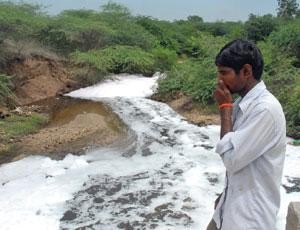India's drug problem (original) (raw)
Chemists show how waste-water contamination affects ecosystem.

Water tested near Hyderabad contains some of the highest environmental drug levels known. Credit: MAHESH KUMAR/AP
Waste flowing out of a treatment plant near Hyderabad in India pollutes the region's waters with some of the highest levels of pharmaceuticals ever detected in the environment. In a paper being released online this week, researchers in Sweden report how this effluent has serious adverse effects on the development of tadpoles and zebrafish1.
The findings raise concerns for the health of wildlife and ecosystems in the region, as well as underscoring little-studied potential effects on human health.
"The volume of drug production in that valley is overwhelming the system," says Stan Cox, a researcher at the Land Institute in Salina, Kansas. "Even though they have good [environmental] laws on the books, they're being swamped by the production."
For several years, the National Geophysical Research Institute in Hyderabad and the country's Central Pollution Control Board in Delhi have monitored heavy metal and other pollutants around the town of Patancheru, which is home to factories producing solvents and other chemicals. But although Patancheru is also home to numerous drug companies, the government has not monitored for drugs being released into the environment.
In 2007, however, a team led by environmental scientist Joakim Larsson of the University of Gothenburg in Sweden published results from one waste-treatment facility, Patancheru Enviro Tech Ltd (PETL)2. Around 90 companies in the region that manufacture active pharmaceutical ingredients, or assemble final drug products, send their waste to PETL. With permission, Larsson's team sampled the waste exiting the plant; they found drugs including the antibiotic ciprofloxacin, at concentrations of up to 31,000 micrograms per litre, and the antihistamine cetirizine, at up to 1,400 micrograms per litre. The team estimated that the amount of ciprofloxacin entering the river from the plant could amount to up to 45 kilograms a day — the equivalent of 45,000 daily doses, says Larsson.
The government has not monitored for drugs being released into the environment.
In new work, he and co-workers exposed tadpoles and zebrafish embryos to diluted PETL effluent, equivalent to river water downstream of the plant. At the lowest concentration tested — equivalent to 1,500 cubic metres of effluent diluted in 750,000 cubic metres of river water, or a 0.2% concentration — the tadpoles experienced 40% reduced growth compared with controls. And at concentrations of 8–16%, zebrafish embryos lost colour and movement within two days of fertilization, among other developmental effects.
Larsson's team has also found drugs in nearby lakes that do not receive effluent from the PETL plant — which suggests that drugs may also be entering the environment by means other than waste-treatment flow. Past reports, including a 2004 review commissioned by the Indian Supreme Court, noted that the PETL plant could not handle all of the waste arriving for treatment over the years. Local villagers speculated that drivers may have dumped their waste elsewhere.
The problem is gaining media attention. In January, The Times of India reported that the office of prime minister Manmohan Singh asked the local pollution board to start collecting data on pharmaceuticals in Patancheru's waters. And an Associated Press report last month triggered a spate of local news stories highlighting the issue.
Sri M. Narayana Reddy, president of the Hyderabad-based Bulk Drug Manufacturers Association (India), questions the validity of the research. In the past decade, Reddy says, drug manufacturers have worked to clean up their effluent, but a legacy of pollution from three decades of chemical manufacturing remains in the region's groundwater and surface water. He also notes that no manufacturer would want to lose such large quantities of a valuable drug such as ciprofloxacin. "At 20 dollars a kilogram, that's not economical," he says. "We suspect the analysis."
But within the Swedish market, Larsson's team obtained a restricted list of which companies produce or buy active pharmaceutical ingredients from India. By matching the list to records from India, they discovered that, out of 242 Swedish products studied, the active ingredient was made in India in 123 cases. Publishing online on 29 January, Larsson and Jerker Fick of Umeå University conclude that 31% of Swedish products are produced at least in part in Patancheru3. They propose that developed countries importing drugs should make sure that the supply chain is open, so that consumers know whether their medicines are made in an environmentally sustainable way.
The Swedish Medical Products Agency in Uppsala will lead discussions this year on how to address the country's de facto export of drug waste. The meetings will include input from the Stockholm-based Swedish Association of the Pharmaceutical Industry (LIF) as part of a special commission to review environmental impacts from manufacturing emissions nationally and internationally. "We cannot move forward on this alone," says Ethel Forsberg, director general of the Swedish Chemicals Agency, which is also party to the discussions.
She notes that polluted waters in the area are used for agriculture and also possibly for household use. The local drug manufacturers "produce medicine of very good quality," she says, "but they really cause severe damage to these people living in India around a facility like this."